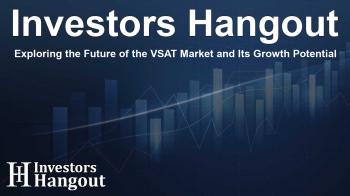Exploring the Future of the VSAT Market and Its Growth Potential

Understanding the VSAT Market Dynamics
The global Very Small Aperture Terminal (VSAT) market is experiencing remarkable growth, valued at approximately US$ 8.9 billion recently. This sector is projected to evolve significantly, aiming for a projected value of around US$ 22.0 billion by the end of the forecast period, reflecting a strong compound annual growth rate (CAGR) of 9.1% from now until 2035.
Reliable connectivity is increasingly essential in our digital age, particularly in remote and underserved regions where traditional infrastructure fails to reach. Industries heavily reliant on uninterrupted communication, including telecommunications, defense, maritime services, and oil and gas, are embracing VSAT technology. The expanding Internet of Things (IoT) further propels the demand for robust and secure global communication networks.
Drivers of Market Growth
The growth trajectory of the VSAT market can be attributed to several key factors:
Rising Demand for Connectivity
The need for dependable connectivity in rural and remote areas is a significant driving force. VSAT systems, with their lightweight and portable dish antennas, facilitate crucial two-way data transmission. Industries, especially those in challenging environments, find these systems indispensable for applications such as internet access, corporate networks, telemedicine, and emergency communications.
Technological Advancements
Recent advancements in satellite technology, including high-throughput satellites and low Earth orbit (LEO) satellite networks, are revolutionizing VSAT operations. These innovations are reducing latency and making bandwidth more affordable, resulting in more reliable connections, especially during peak usage periods.
Market Overview: A High-Growth Landscape
The global VSAT market is poised for robust expansion in the coming years, driven by:
- Widespread Broadband Access: Increasing efforts to provide broadband in underdeveloped areas are expanding the market's reach.
- Maritime and Aviation Communications: The need for real-time communications for maritime and aviation sectors continues to surge.
- Investments in Satellite Technologies: Continued government and military investments promote secure, high-bandwidth VSAT networks.
- 5G and VSAT Technology Integration: The merging of 5G networks with VSAT technology is transforming global connectivity.
Competitive Landscape: Leading Players
Several prominent companies are defining the powers of the VSAT market through continuous innovation. Key participants in this industry include:
- Hughes Network Systems, LLC - Noted for its broadband satellite services.
- Viasat Inc. - Renowned for high-speed satellite internet and secure networks.
- Inmarsat Global Ltd. - Specializes in connecting maritime and aviation sectors.
- Gilat Satellite Networks - A leader in cost-effective VSAT solutions.
- Cobham plc - Known for its satellite terminals and antennas.
- SES S.A. - Innovator in global satellite coverage technologies.
- Intelsat - Enhancing connectivity via advanced satellite networks.
Emerging Trends and Future Outlook
As the VSAT market progresses, several trends indicate a promising future, including:
- Growth of 5G-Enhanced Satellite Networks: Efforts to unite terrestrial and satellite communication for seamless connectivity.
- Increased Funding for Space Technology: Government support for secure military and civilian applications of VSAT is on the rise.
- Intelligent VSAT Solutions: Smart technology will support IoT and edge computing capabilities.
- Demand for In-Flight and Maritime Connectivity: The push for real-time communication in airlines and shipping industries grows.
Challenges Facing the VSAT Market
Despite the promising outlook, the VSAT industry faces challenges, such as:
- High Initial Investment: The capital requirement for deploying VSAT infrastructure can be significant.
- Regulatory Challenges: Government regulations may hinder expansion opportunities.
- Direct Competition from Fiber Optics: Terrestrial optic networks pose limitations in urban areas.
- Latency Issues: Existing limitations with traditional satellite networks still affect performance.
Frequently Asked Questions
What is the current value of the global VSAT market?
The global VSAT market was valued at approximately US$ 8.9 billion recently.
What is the expected growth rate for the VSAT market?
The market is anticipated to grow at a CAGR of 9.1% from now until 2035.
What are the major factors driving VSAT demand?
Key drivers include the increasing need for reliable connectivity and the growth of IoT applications.
Which segments dominate the VSAT market?
The dedicated bandwidth VSAT systems accounted for the largest share of the market.
Which geographical region is most appealing for VSAT providers?
East Asia has been recognized as a primary region for market growth due to its technological advancements.
About The Author
Contact Kelly Martin privately here. Or send an email with ATTN: Kelly Martin as the subject to contact@investorshangout.com.
About Investors Hangout
Investors Hangout is a leading online stock forum for financial discussion and learning, offering a wide range of free tools and resources. It draws in traders of all levels, who exchange market knowledge, investigate trading tactics, and keep an eye on industry developments in real time. Featuring financial articles, stock message boards, quotes, charts, company profiles, and live news updates. Through cooperative learning and a wealth of informational resources, it helps users from novices creating their first portfolios to experts honing their techniques. Join Investors Hangout today: https://investorshangout.com/
The content of this article is based on factual, publicly available information and does not represent legal, financial, or investment advice. Investors Hangout does not offer financial advice, and the author is not a licensed financial advisor. Consult a qualified advisor before making any financial or investment decisions based on this article. This article should not be considered advice to purchase, sell, or hold any securities or other investments. If any of the material provided here is inaccurate, please contact us for corrections.

